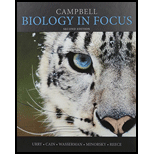
Concept explainers
To explain:
DNA sequence data for diplomonad, euglenozoan, a plant and an unidentified protist suggest that the unidentified species is mostly closely related to the diplomonad. Further studies reveal that the unknown species has fully functional mitochondria. Based on these data, at what point on the Phylogenetic tree given in Figure 25.9 “Exploring Eukaryotic Diversity”, in the textbook, did the mystery protists lineage probably diverge from other eukaryotic lineages.
Introduction:
The diplomonads are the group of flagella containing organisms and are mostly
Trending nowThis is a popular solution!

Chapter 25 Solutions
Campbell Biology in Focus; Modified Mastering Biology with Pearson eText -- ValuePack Access Card -- for Campbell Biology in Focus (2nd Edition)
- Order the events relative to one another based on when each occurred in the fossil record. Earlier Laterarrow_forwardEndosymbioses that lead to the evolution of euglenoids and, separately, the evolution of chlorarachniophytes were the result of the combining of: a. two ancestral nonphotosynthetic prokaryotes. b. two ancestral photosynthetic prokaryotes. c. a nonphotosynthetic eukaryote with a photosyntheticeukaryote. d. a photosynthetic prokaryote with a nonphotosyntheticeukaryote. e. mitochondria with an already established plastid.arrow_forwardRedraw the phylogeny of eukaryotes, expanded to show different members (e.g. dinoflagellates, diatoms) of the supergroups as necessary and indicate the location of the primary endosymbioses for mitochondria and chlorophyll on the phylogeny. Indicate the location of three secondary endosymbioses leading to chloroplasts and one location showing the loss of mitochondria on the same phylogeny.arrow_forward
- What are one of the main traits that make bacteria and archae unique in comparison to protists, fungi, amáinala and plants? - they have RNA -fungi have chitin - they are single called organismos that do not have membrane bound organelles or bucked - they diverged 3 billion years ago from each other - they have glycolysisarrow_forwardwrite in 5 paragraphs Protists are the most varied group of organisms that we studied this term. They display unique adaptations in feeding, reproduction, and lifestyle (parasitism, free living, etc) among many others! Discuss protist evolution, including an overview of the major groups, and the breadth of variations that occur within this paraphyletic clade. How did protists lead to the evolution of the rest of life on Earth?arrow_forwardDescribe two ways in which paramecium differs from the projected traiits of the last eukaryotic common ancestor.arrow_forward
- Protists are the most varied group of organisms that we studied this term. They display unique adaptations in feeding, reproduction, and lifestyle (parasitism, free living, etc) among many others! Discuss protist evolution, including an overview of the major groups, and the breadth of variations that occur within this paraphyletic clade. How did protists lead to the evolution of the rest of life on Earth?arrow_forwardGive an example of a protist that is:(a) a parasite of humans(b) very large and photosynthetic(c) a unicellular species with two flagella and photosynthetic(d) covered in ciliaarrow_forwardThis chapter shows a phylogenetic tree for the three domains of life, which is based on DNA sequence data for rRNA and other genes. Which of the following answers concerning the phylogenetic relationships found within this tree is incorrect? View Available Hint(s)for Part A Euryarcheotes are found in the Archaea Diatoms, Tubulinids, and Euglenozoans belong to the domain Eukarya Forams, Fungi, and Chlamydias belong to the domain Eukarya. Spirochetes belong to the domain Bacteria Ciliates, Red Algae, and Plants belong to the domain Eukarya.arrow_forward
- 50) Some protists, formerly united as the ʺamitochondriateʺ clade, have recently been shown to be rather diverse. Some of them possess neither mitochondria nor mitochondrial genes (and have been classified as fungi). Others possess no mitochondria, but do have mitochondrial genes in their nuclear genome. Still others have modified mitochondria (viz. mitosomes or hydrogenosomes). Which statement(s) represent(s) consequences of these recent findings? 1. The amitochondriates do not comprise a true clade. 2. The ʺamitochondriate hypothesisʺ concerning the root of the eukaryotic tree has been strengthened. 3. Just as there is a diversity of cyanobacterial descendants among eukaryotes, so too is there a diversity of alpha-proteobacterial descendants among the eukaryotes. 4. If the amitochondriate organisms continued to be recognized as a taxon, this taxon would be polyphyletic. 5. Horizontal gene transfer involving mitochondrial genes has occurred in some amitochondriate organisms. A) 1 only…arrow_forwardMembers of the kingdom Protista differ from members ofthe kingdom Monera mainly due to the presence of:(a) RNA(b) Ribosomes(c) Cell wall(d) DNA(e) Membrane-bound nucleusarrow_forwardEVOLUTION LINK Why are the protists considered paraphyletic? Use Figure 26-3 to help explain your answer.arrow_forward
 Biology: The Dynamic Science (MindTap Course List)BiologyISBN:9781305389892Author:Peter J. Russell, Paul E. Hertz, Beverly McMillanPublisher:Cengage Learning
Biology: The Dynamic Science (MindTap Course List)BiologyISBN:9781305389892Author:Peter J. Russell, Paul E. Hertz, Beverly McMillanPublisher:Cengage Learning Biology (MindTap Course List)BiologyISBN:9781337392938Author:Eldra Solomon, Charles Martin, Diana W. Martin, Linda R. BergPublisher:Cengage Learning
Biology (MindTap Course List)BiologyISBN:9781337392938Author:Eldra Solomon, Charles Martin, Diana W. Martin, Linda R. BergPublisher:Cengage Learning Biology 2eBiologyISBN:9781947172517Author:Matthew Douglas, Jung Choi, Mary Ann ClarkPublisher:OpenStax
Biology 2eBiologyISBN:9781947172517Author:Matthew Douglas, Jung Choi, Mary Ann ClarkPublisher:OpenStax Biology Today and Tomorrow without Physiology (Mi...BiologyISBN:9781305117396Author:Cecie Starr, Christine Evers, Lisa StarrPublisher:Cengage Learning
Biology Today and Tomorrow without Physiology (Mi...BiologyISBN:9781305117396Author:Cecie Starr, Christine Evers, Lisa StarrPublisher:Cengage Learning



